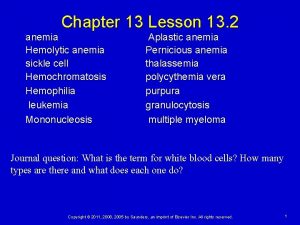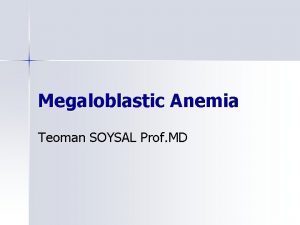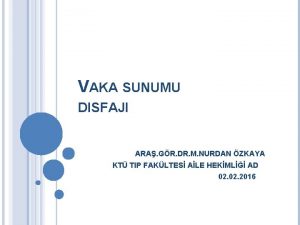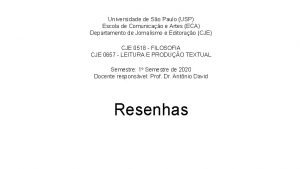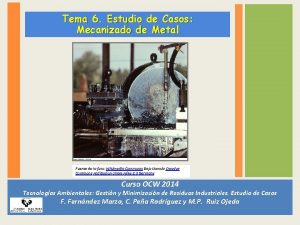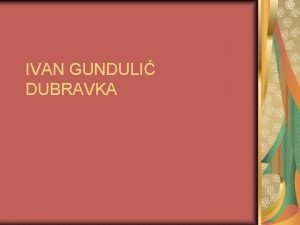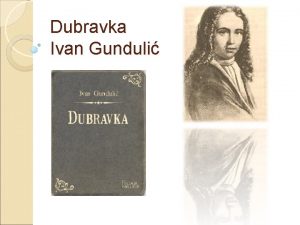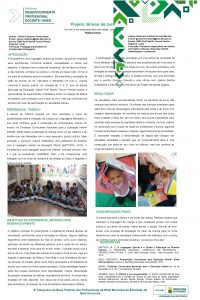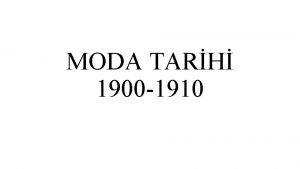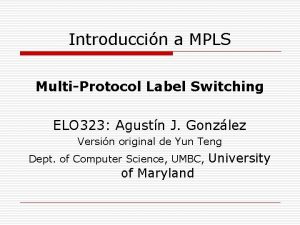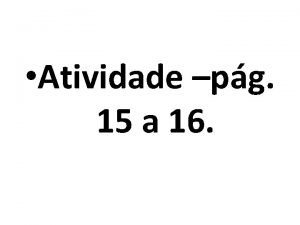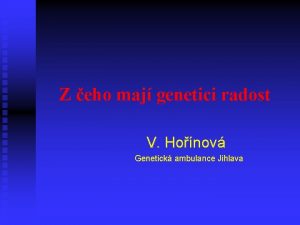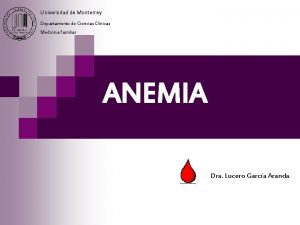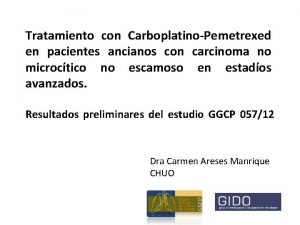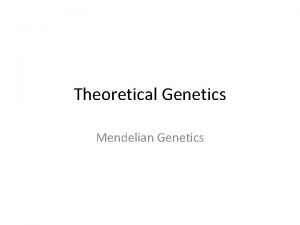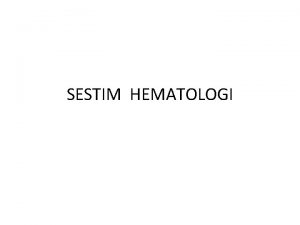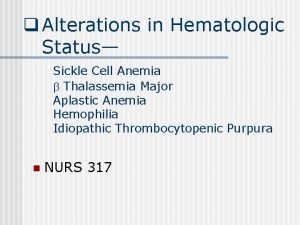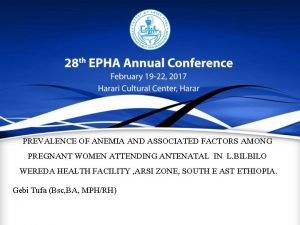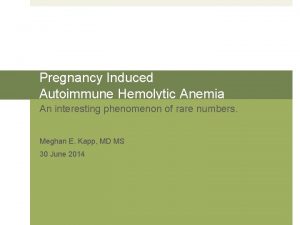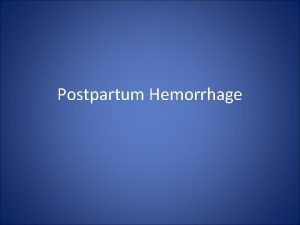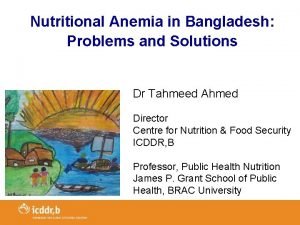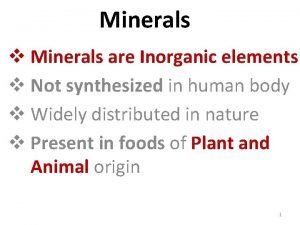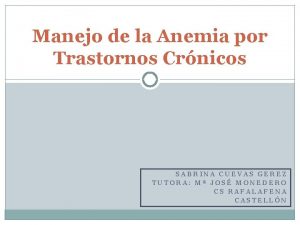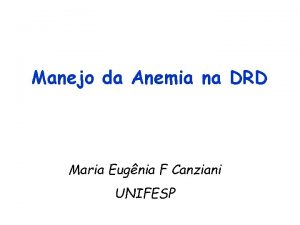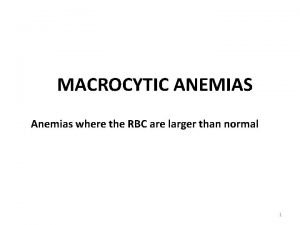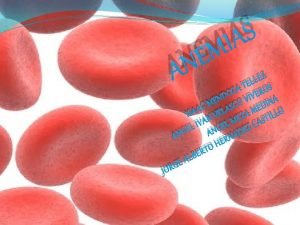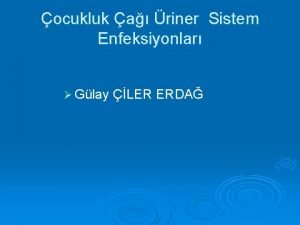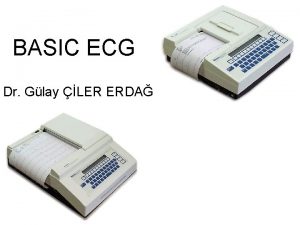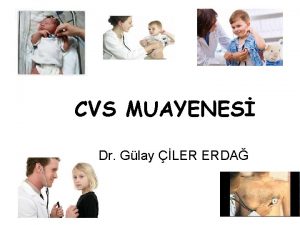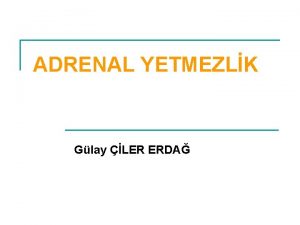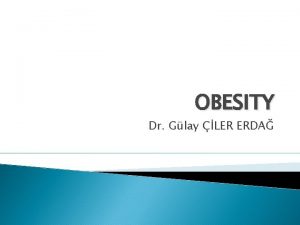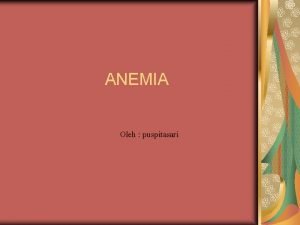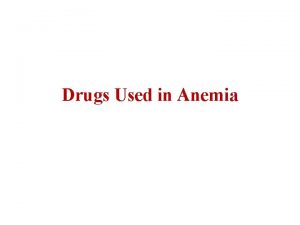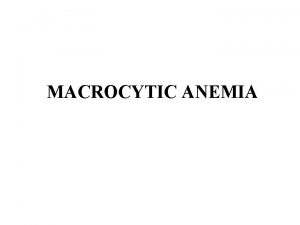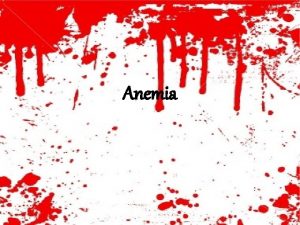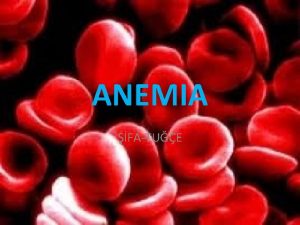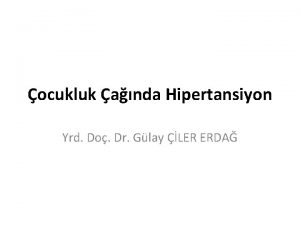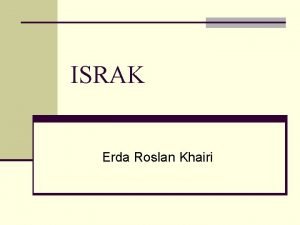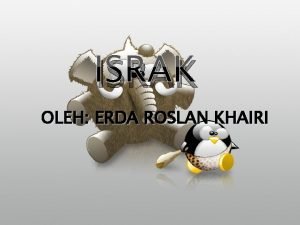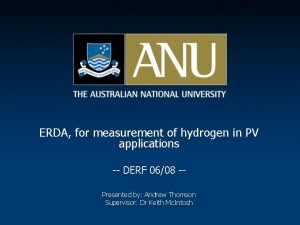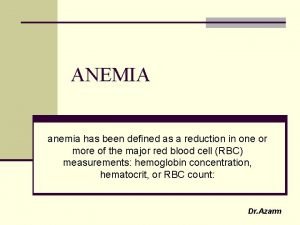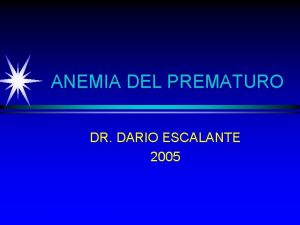Introduction to anemia Glay LER ERDA MD n



















































- Slides: 51

Introduction to anemia Gülay ÇİLER ERDAĞ, MD

n Hematopoiesis n n Begins in the embryo during the third week of gestation Developmental hematopoiesis occurs in three stages n Mesoblastic n n Hepatic n n In the yolk sac first produces erythrocytes and leukocytes By the 12 th week of gestation liver and the spleen are the predominant sites Myeloid n By the 30 weeks gestation, the bone marrow assumes its

Age Site of hematopoiesis Embryo yolk sac then liver 3 rd to 7 th month Spleen and liver 4 th and 5 th months marrow cavity - esp. granulocytes and platelets 7 th month marrow cavity - erythrocytes Birth mostly bone marrow; spleen and liver when needed Birth to maturity number of active sites in bone marrow decreases but retain ability for hematopoiesis Adult bone marrow of skull, ribs, sternum, vertebral column, pelvis, proximal ends of femurs


n The predominant cellular element in the blood is eryhtrocyte: RBC (red blood cell) n Under the stimulus of erhythropoietin and other humoral factors n erythroid burst forming units (from the pluripotent stem cells) and colony forming units give rise to identifiable erythroblasts n Begin to synthesize Hb n Nucleated RBC n Nucleus extruded Young erythrocyte



n n Hb n Binds to oxygen in the lungs and transports it to the tissues n Tetramer consisting of two pairs of unlike polypeptide chains each attached to a HEME ( molecule of protoporphyrin ferrous iron) The primary Hb n n in the postnatal life is Hb. A (2α 2β) Initial months of gestation Hb. F (2α 2γ)



n n At the time of birth γ and β chain synthesis is approximately equal and 60%-80% of the total Hb is Hb. F γ glb synthesis almost ceases during the initial months of life n n By 6 months of age the percentage of Hb. F approximates that of adults(<2%) Hb. F is resistant to both alkali and dilute acid. It binds less avidly than does Hb. A to 2, 3 diphosphoglycerate n n an organic phosphate in the erythrocyte important in modulating oxygen uptake and release by Hb The affinity of Hb. F for oxygen is high


n Because of intrauterine hypoxia and the high affinity of Hb. F for oxygen(resulting in a shift to the left of oxygen-Hb dissociation curve) Erythropoietin secretion is enhanced during fetal life n During the final months of gestation and at birth values for Hb and Hct are higher than those for older children n

n Hemoglobin F (Hb F), composed of 2 alpha and 2 gamma globin chains, is the normal hemoglobin of the fetus and newborn. Normally in the second trimester, gamma chain production (and Hgb F levels) decrease and beta chain production increases, resulting in increasing levels of hemoglobin A (Hb A), the major normal adult hemoglobin (2 alpha and 2 beta globin chains). Hemoglobin A 2 (Hb A 2) (2 alpha and 2 delta globin chains) also comprises a small amount (<3. 3%) of n n n n Reference Values HEMOGLOBIN A 2 1 -30 days: 0. 0 -2. 1% 1 -2 months: 0. 0 -2. 6% 3 -5 months: 1. 3 -3. 1% > or =6 months: 2. 0 -3. 3% HEMOGLOBIN F 1 -30 days: 22. 8 -92. 0% 1 -2 months: 7. 6 -89. 8% 3 -5 months: 1. 6 -42. 2% 6 -8 months: 0. 0 -16. 7% 9 -12 months: 0. 0 -10. 5% 13 -17 months: 0. 0 -7. 9% 18 -23 months: 0. 0 -6. 3% > or =24 months: 0. 0 -0. 9%

n n Newborns less than one week old have hemoglobin of 14 -22 g/dl. By six months of age, hemoglobin runs between 11 and 14 g/dl. Between 1 year and 15 years of age hemoglobin runs between 11 -15 g/dl. Normal adult hemoglobin depends on gender: n n n ♀ ♂ 12 -16 g/dl 14 -18 g/dl In geriatric age group, men and women have same hemoglobin range: 12 -16 g/dl. 15

Anemia n A reduction in RBC volume or Hb concentration below the range of values occurring in healthy person n Although a reduction in the amount of circulating Hb decreases the oxygen carrying capacity of the blood few clinical disturbances occur until Hb levels fall below 78 gr/dl n Below this level pallor becomes evident in the skin and mucous membranes

Physiologic adjustments to anemia n Increased cardiac output n Increased oxygen extraction n Shunting of blood flow toward vital organs and tissues n In addition the concentration of 2, 3 DPG increases n Shift to the right of oxygen dissociation curve, reducing the affinity of Hb for oxygen n results in more complete transfer of oxygen to the tissues

n Anemia can be defined as a reduction in the hemoglobin, hematocrit or red cell number n The pathophysiologic effects of anemia depend upon the rate at which the anemia progresses

n In an acute hemorhage n the arterial pressure falls, cardiac output decreases, peripheral vasculature collapses and the patient rapidly enters hypovolemic shock n The sudden rapid loss of 30% of the total blood volume often results in death unless there is immediate medical intervention

n In a slowly developing anemia n cardiac output increases, blood shunted from nonvital organs and hemoglobin oxygen affinity decreases due to increased levels of 2, 3 DPG. n Total blood volume remains remarkably constant. More than 50% of the red cell mass can be lost slowly with minimal effects

n It must be remembered that anemia is not a disease rather it’s a sign of disease n The clinical effects (lack of oxygen) include n Tiredness, lassitude, weakness, pallor n Dyspnea and anginal pain are not uncommon after exercise n Jaundice may occur in some anemias

Classification of Anemias n Have a variety of ways - depending on criteria used: Functional n Morphological n Clinical n Quantitative n 22

Functional Classification of Anemias n Decreased RBC production (hypoproliferative) n Defective hemoglobin synthesis n n n Fe deficiency B 12 deficiency Folate deficiency Impaired bone marrow or stem cell function, as in leukemia Increased RBC destruction, as in sickle cell anemia or hemolytic anemia Combination of the two (sometimes called “ineffective erythropoiesis”) 23

Morphological Classification of Anemias n Morphological based on sizes and color of RBCs Normochromic n Hypochromic n Normochromic Normocytic Microcytic Macrocytic n 24

Clinical Classification of Anemias n According to their associated causes: Blood loss n Iron deficiency n Hemolysis n Infection n Nutritional deficiency n Metastatic bone marrow replacement n 25

Quantitative Classification of Anemias n Quantitatively by: Hematocrit n Hemoglobin n Blood cell indices n Reticulocyte count n 26

Hemoglobin and Hematocrit 1 of 2 n n Anemia usually diagnosed on either hemoglobin or hematocrit values. Remember, normal ranges vary depending on age, gender, state of hydration, patient positioning and local patient population. 27

Hemoglobin and Hematocrit 2 of 2 n n n On basis of H&H, anemia can be classified as mild, moderate, or severe. On basis of duration of onset, anemia can be classified as either chronic or acute. Rules of Three: n n RBC X 3 = Hemoglobin X 3 = Hematocrit Ratio of Hb and Hct will vary with cause of anemia and affect the RBC indices, particularly the MCV (Mean Corpuscular Volume). Microscopic examination of peripheral blood smear is required for evaluation of anemia. Bone marrow aspirates and smear evaluation may also be needed. 28

RBC Indices n RBC indices include: Mean Corpuscular Volume (MCV) n Mean Corpuscular Hemoglobin (MCH) n Mean Corpuscular Hemoglobin Concentration (MCHC) n RBC Distribution Width (RDW) n 29

MCV n n n n Mean cell volume MCV is average size of RBC MCV = Hct x 10 RBC (millions) If 80 -100 f. L, normal range, RBCs considered normocytic If < 80 f. L are microcytic If > 100 f. L are macrocytic Not reliable when have marked anisocytosis 30

MCH is average weight of hemoglobin per RBC. n MCH = Hgb x 10 RBC (millions) n 31

MCHC is average hemoglobin concentration per RBC n MCHC = Hgb x 100 Hct (%) n If MCHC is normal, cell described as normochromic n If MCHC is less than normal, cell described as hypochromic n There are no hyperchromic RBCs n 32

RDW Most automated instruments now provide an RBC Distribution Width (RDW) n An index of RBC size variation n May be used to quantitate the amount of anisocytosis on peripheral blood smear n Normal range is 11. 5% to 14. 5% for both men and women n 33

RBC Indices and Other Tests n n n RBC indices are automatically calculated by instruments. Microscopic evaluation will determine if RBCs are normocytic, microcytic, or macrocytic and normochromic or hypochromic. Use of RBC indices in differential diagnosis can provide picture of what is occurring clinically. If anemia caused be bone marrow failure, requires information about RBC production. Information obtained from reticulocyte count. Reticulocyte count measures effective RBC production. As study different anemias, will learn morphology. 34

Treatment of Anemias Treated according to cause; Should know cause before beginning treatment. n Patient can have more than one cause of anemia. n Must use diagnostic tests to determine cause(s). n Do diagnostic tests before transfusions, because transfusions obscure and confuse findings. n 35

Hgb (In the Diagnosis of Anemia) n n Hbg is the main component of RBCs and carries oxygen to tissues. Three methods to measure hemoglobin: n n n Cyanmethemoglobin (recommended method) Oxyhemoglobin Iron Content 36

Hct (In the Diagnosis of Anemia) n n n 1 of 3 Is packed RBC volume Is ratio of RBC volume to volume of whole blood Usually expressed in percentage (42%) or as decimal fraction (. 42) Venous and arterial hematocrits closely agree Specimen of choice is EDTA (ethylenediaminetetra acetic acid), oxalate or heparin 37

Hct (In the Diagnosis of Anemia) n n 2 of 3 Measurement done by centrifugation or through calculations performed on many automated measurements. Calculated hematocrit is product of MCV and RBC count. Normal ranges are 42 -52% in men and 3747% in women. Normal ranges also vary among age groups, institutions, and geographic locations. 38

RBC Indices (In the Diagnosis of Anemia) 1 of 2 n n RBC indices are readily available from the automated hematology counting devices MCV is measured directly or calculated from hematocrit and RBC count; MCH and MCHC are both calculated 39

RBC Indices (In the Diagnosis of Anemia) 2 of 2 n In various anemic states, indices may be altered: n Microcytic Anemia: n n MCV usually 50 -80 f. L MCH usually 15 -25 pg MCHC usually 22 -30% Macrocytic Anemia: n MCV usually 100 -120 f. L 40

Peripheral Blood Smear (In the Diagnosis of Anemia) n n Very useful in diagnosing and classifying anemias Look for: n n n Neutropenia Thrombocytopenia Hypochromia Size and shape of RBCs Unusual leukocytes (hypersegmentation) Red cell inclusions: basophilic stippling, Howell-Jolly bodies… 41

Reticulocyte Count (In the Diagnosis of Anemia) n n n Useful in determining response and potential of bone marrow. Reticulocytes are non-nucleated RBCs that still contain RNA. Visualized by staining with supravital dyes, including new methylene blue or brilliant cresyl blue; RNA is precipitated as dye-protein complex. Normal range is 0. 5 -2. 0% of all erythrocytes. If bone marrow responding to anemia, should see increases in retic count. Newborns have higher retic count than adults until second or third week of 42 life.

Bone Marrow (In the Diagnosis of Anemia) n Bone marrow aspiration and biopsy are important diagnostic tools in the determination of anemia. 43

Other Tests (In the Diagnosis of Anemia) Hemoglobin Electrophoresis n Antiglobulin Testing n Osmotic Fragility n Sugar Water Test n Ham’s Test n RBC Enzymes n B 12, Fe, TIBC, Folate Levels n 44

n Anemia is usually classified according to n Etiology n Pathophysiology n Morphology

Laboratory diagnosis n Initial investigation and tentative diagnosis is made with a relatively small number of tests n The precise diagnosis is made with further special tests n Screening is usually done with CBC (complete blood count) n The exact procedures in a CBC depends upon the instrumentation in the laboratory

n Most laboratories now use automated multiparameter instruments. These are n n n n n Hb(hemoglobin) RBC MCV Htc(hematocrit) MCHC RDW WBC Platelet and MPV Directly measured values Calculated values

n MCV: Htc X 10 (90± 7 fl) RBC Hb X 100 n MCH: n MCHC: (30± 3) RBC Hb X 100 Htc (33± 2)

spherocytosis poikilocytosis acanthocytosis eliptocytosis stomatocytosis Fragmentation hemolysis

Sickle cell anemia; target cells and sickled cells Target cells Thalassemia; severe hypochromia Normal RBC Heinz body anemia Anisopoikilocytosis, target cells

normal Hypochromic, microcytes macrocytes Target cells schistocytes
 Erda acres water company
Erda acres water company Glay'z
Glay'z Pernicious anemia vs megaloblastic anemia
Pernicious anemia vs megaloblastic anemia Megaloblastic anemia lab values
Megaloblastic anemia lab values Megaloblastic anemia laboratory findings
Megaloblastic anemia laboratory findings Meckel divertikülü 2'ler kuralı
Meckel divertikülü 2'ler kuralı Textos argumentativos para ler
Textos argumentativos para ler Codigo ler taladrina
Codigo ler taladrina A tree falls the way it leans quote meaning
A tree falls the way it leans quote meaning Dubravka ivan gundulić
Dubravka ivan gundulić Ensinar a ler, ensinar a compreender teresa colomer resumo
Ensinar a ler, ensinar a compreender teresa colomer resumo Dubravka ribar
Dubravka ribar Como ler bem
Como ler bem Se 6 impressoras iguais produzem 1000 panfletos
Se 6 impressoras iguais produzem 1000 panfletos Um livro é um brinquedo feito com letras. ler é brincar
Um livro é um brinquedo feito com letras. ler é brincar Ler network
Ler network 1900 ler modası
1900 ler modası Leitura para atpc
Leitura para atpc The once-ler describes a glorious place
The once-ler describes a glorious place Ler palavras enganosas
Ler palavras enganosas Site para ler livros
Site para ler livros Podes ler
Podes ler Sünnet manileri
Sünnet manileri The death of the pc ao optar por ler
The death of the pc ao optar por ler Podes ler
Podes ler Uiuc ler
Uiuc ler Elo-323
Elo-323 Nele pode se ler a seguinte afirmação
Nele pode se ler a seguinte afirmação Ler texto abaixo
Ler texto abaixo Mikromandibula
Mikromandibula Angioectasia icd 10
Angioectasia icd 10 Clasificación morfológica de las anemias
Clasificación morfológica de las anemias Grados de anemia
Grados de anemia Genotypic ratio of monohybrid cross
Genotypic ratio of monohybrid cross Hematogi
Hematogi Hemoglobina normal en adolescentes
Hemoglobina normal en adolescentes Aplastic crisis
Aplastic crisis Anemia in pregnancy guideline
Anemia in pregnancy guideline Hemolysis treatment
Hemolysis treatment Anemia and uterine atony
Anemia and uterine atony Bimanual compression
Bimanual compression Intravascular hemolytic anemia
Intravascular hemolytic anemia Gambar anemia sel sabit
Gambar anemia sel sabit Anemia in bangladesh
Anemia in bangladesh Missense mutation in sickle cell anemia
Missense mutation in sickle cell anemia Minerals are inorganic elements that the body
Minerals are inorganic elements that the body Lab tests for anemia
Lab tests for anemia Sabrina prater
Sabrina prater Anemia normocítica normocrômica
Anemia normocítica normocrômica Macrocytic anemia
Macrocytic anemia Macrocytic non megaloblastic anemia
Macrocytic non megaloblastic anemia Anemia microcitica
Anemia microcitica


